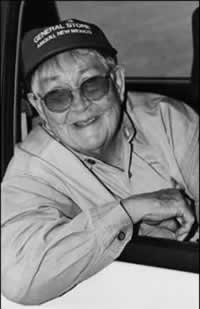Santa Fe Living Treasures – Elder Stories
|
|
Maria ChabotIn 1936, at the height of the Great Depression, 23-year-old Maria Chabot was executive secretary of the New Mexico Association of Indian Affairs, an advocacy group promoting native arts and crafts. A frequent visitor to Mexico, she saw that the Indians there seemed better off than those in New Mexico. A key difference, she noted, was that the Mexican natives had easy access to markets where they sold their handmade wares, while Indians north of the border did not. So she organized a weekly market under the portal of the Palace of the Governors on the Plaza in Santa Fe. It was the beginning of the modern-day Santa Fe Indian Market, the biggest such even in the world. Historically, the market traces to 1922, when the annual Indian Fair was started by the Museum of New Mexico. But from 1932 to 1935, the fairs ceased in the Depression. Mari's idea was not to revive the annual event, but merely to give Indian artists a place to sell their work, to make enough money to get by. Realizing that a major problem was that they had no transportation fro their pueblos to Santa Fe, she arranged for school buses to bring them. Artists from one pueblo each weekend would come to the Palace. Maria was touched when eight of the earliest vendors told her they were using their earnings to install running water in their homes. Some Santa Fe merchants objected vigorously to the new competitions, but the native sales became a custom. After a while the artists came daily, and things grew into the Santa Fe Indian Market. Another post held by Maria was with the Federal Indian Arts and Crafts Board, working all over the West. Nor was the Indian art the only major aspect of Maria's life. Texas-born, after the family of her grandfather the British ambassador to Mexico, fled the Revolution of 1910, she moved to Santa Fe in 1931 at the age of 18. In her 20s she made her way to the East Coast, took a freighter to Europe, and spend two years traveling and working in France. Back in New Mexico, she plunged into promoting Indian causes. In 1935 Maria met another champion of native culture, Mary Cabot Wheelwright, who founded what is today the Wheelwright Museum of the American Indian in Santa Fe. As an accomplished photographer, Maria was hired to record Wheelwright's extensive collection of art, and the two became close friends. A Boston heiress, Wheelwright owned an estate north of Santa Fe in the Village of Alcalde. She named it Los Luceros ("The Stars"), and Maria became its supervisor, hiring labor, managing herds, and planting more than 1,500 fruit trees. (After being listed on the National Register of Historic Places, Los Luceros was acquired by the state in 2008). Wheelwright introduced Maria to famed artist Georgia O'Keeffe in 1940, and another great collaboration followed. Maria spent summers with O'Keeffe at Ghost Ranch in Abiquiu, took camping trips with the artist, and photographed the iconic image of O'Keeffe riding off behind a motorcycle driver, with an impish gleam in her eyes. Maria was hired to refurbish a crumbling adobe structure in Abiquiu, which eventually became O'Keeffe's permanent home. It is now listed as a national landmark. In her last years, Maria was compiling a book on her correspondence with O'Keeffe. After she died, it was published, and was hailed for "soul-touching beauty."
Story by Richard McCord Photo © 1994 Nancy Dahl |

